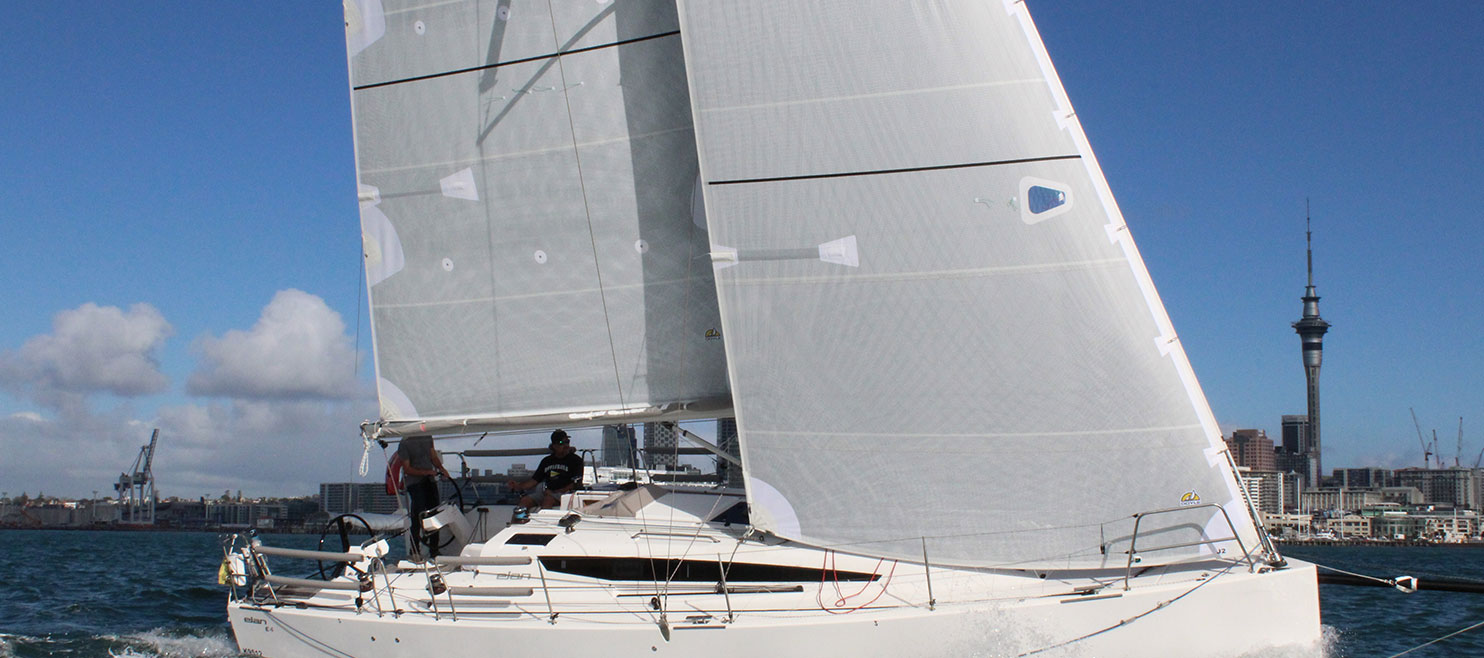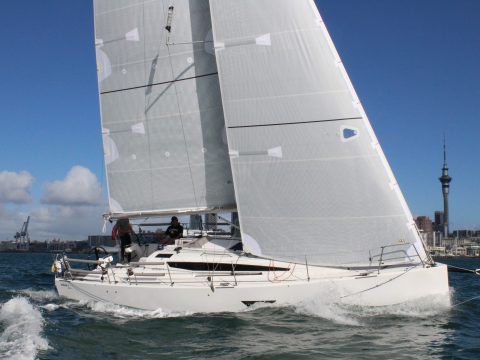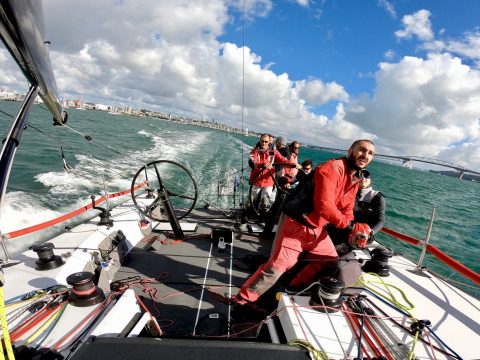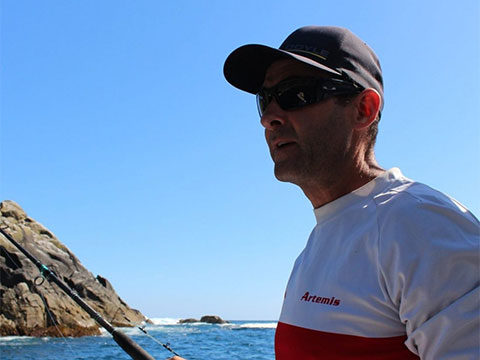
Light enough, fast enough… AND strong enough
November 27, 2020
Stefano Nava, the Italian designer for Doyle Sails.
November 27, 2020New Cruising Sails – Optimising a Yacht’s Performance

By Mark Seabrook for Live Sail Die. For more articles by Mark, go to livesaildie.com
When I purchased Matinee, a thirty-year-old Alan Wright Lotus 10.6 [36’] – regarded as a cruiser/racer – it was unlikely that it was going to come with a respectable sail wardrobe. After two years, now could be a good time to consider how to optimise her performance with new sails.
For a first-time owner, a couple of years – and a number of cruising miles under the keel – seems a reasonable period of time to understand how your boat performs in different sailing conditions and what type of sailing is preferred – important information for what must rate as one of the more exciting additions to a yacht.
Choosing a sailmaker
The first of many important decisions is which sailmaker to use. Although brand loyalty plays a big part in sail choice for many yachties, it may be worth the exercise to see what else is on offer. What seems more important (alongside quality and reliability) is the backup and support – and the personal relationship you develop with your sailmaker so that you get the best product for your needs rather than just the best product.
Without doubt, experience and knowledge is an essential part of any successful relationship, and Andy Pilcher from Doyle Sails is a name often mentioned around the boatyards as someone well worth having a conversation with. Andy has worked for Doyle Sails for nearly 30 years and in his time, he’s seen the full evolution of sail manufacturing from the simplest of materials and techniques through to today’s new generation of high-tech and highly specialised team of sailmakers.
Replacing the Headsail AND the Mainsail?
Andy advises, “There are certainly reasons to look at replacing both sails at the same time if the budget allows. Obviously, the boat will benefit from the combined power of two new sails working together.” He adds, “We’ve often fitted a new headsail to a boat, and it’s made such a difference that the owner calls up the following week and says, ‘Well, I guess you’d better do the mainsail as well …”
Fortunately, the age and condition of the headsail and the mainsail on Matinee warrants extending the budget to replacing them both.

Also worth keeping in mind is that you’ll have more bargaining power with your supplier if you’re considering more than one sail at a time. If you want to further justify the investment, buying new sails can be regarded as positive capital expenditure. It’s long been regarded in the marine industry that the key components of a yacht that help determine its value are the condition of the engine, the hull and the rig closely followed by the sails - as they’re what drive the boat most of the time, and depending on their condition can be of relative value
Identifying Your Type
Andy was available to meet at Doyle Sails Auckland head office and to kick things off he outlined three cruising categories to identify with.
The first is the Weekend Cruiser who’s happy to be out there, put the sails up and get from A to B with less concern about the performance of others.
Then you have the Pure Cruiser who’s interested in getting the best performance out of the boat, and if there’s a similar boat alongside, then a bit of trimming is undertaken to find an edge... also referred to as a ‘closet racer’.
Thirdly is the Competitive Cruiser who cruises and events. These sailors tend to work within the margins, are not averse to be reducing onboard weight for racing and are known to do whatever it takes to win.
For this sailor though, the second category – a ‘Pure Cruiser’ – sounds about right, and sounds like the budget can be kept in check.
“Having some experience and knowing what you want to achieve from your sailing will quickly narrow the many permutations of sail options available” Andy said.
Sail Materials
The next consideration made absolute sense; when selecting sail material quality and therefore cost, it pays to be aware of their different applications with their intended purpose. Saving money on quality without balancing the equation can sometimes work against you.
Andy explains “Anytime the wind is forward of the beam, the headsail does most of the work and therefore it is exposed to different loads than the mainsail. The mainsail is also fully battened and supported on the rig. Both these factors provide an opportunity to spend a bit more in terms of quality of the cloth on the headsail and allow some saving on the mainsail without compromising performance.”
Selecting sail materials within your sailing category and budget is where Andy’s expertise becomes crucial.
Broadly speaking, there are three main sail materials in the cruising category:
1. Dacron
2. Cruise Laminates
3. Custom Laminated Membranes.
In brief terms, Dacron is a durable woven cloth offering reasonable performance particularly when new, and it’s the most economical sail material. Dacron’s disadvantage is that it does stretch, and over time, the sail shape gets deeper and moves aft. Dacron quality can range and this becomes an important consideration as to the sail’s durability and performance.
Cruise Laminates are, as the name suggests, a laminated material – two layers of taffeta laminated both sides of a film-encapsulated scrim that takes the structural load. This combined construction offers less stretch, hold the sail’s shape and is lighter, providing ease of handling. Cruise Laminate are 20-30% more expensive than Dacron due to added labour and materials; however, due to its complex structure, it doesn’t like flapping or mishandling.
At the top of the coastal cruising range is Doyle Sail’s Delta membrane. This is a custom laminated sail where the sail laminates are built to the required size and shape. Whereas Dacron and Cruise Laminates are panel sails and come in rolls from the supplier, with Delta membrane every sail membrane is custom-made. Therefore, the cost can be up to twice the price of Dacron. However, there are some exceptional advantages in performance, strength and durability.
For Matinee Andy quickly summarised a suitable cruising sail selection. “Ideal for this project would be to consider a good quality Dacron for the mainsail and a cruise laminate for the headsail.”

Cost and Expectations
The next step of getting a quote is where some key decisions start to get made. “It’s always a good idea to provide pricing options around the discussions to this point, just in case budget expectations differ or ideas on sailing performance or even aspirations change from talking through the different scenarios” says Andy.
Boat Visit and Final Details
Once there’s some direction in sail options and cost, it’s a good time to meet at the boat to refine the details and measure up. Andy was quick to clarify: “We don’t like building new sails off the old sails; it’s all about building the new sails to the boat’s set-up and rigging dynamics.”
Apart from the overall sail measurements, other important information can be gathered from a boat visit such as the reef points and batten configuration in the mainsail, and how does the backstay integrate with the mainsail. Some sailors prefer the mainsail not to overlap the backstay, while others are happy for it to ‘brush’ the backstay to maximise sail area and improve performance.
What size for the headsail? Typically on a Lotus 10.6 a No 2 gives 135% overlap providing a good range so as to minimise the need to partially furl the sail, which compromises performance. What height should the clew be off the deck? The lower the clew the greater the sail area and performance; however, cruisers often prefer a higher clew for visibility and to minimise the headsail catching water that comes across the foredeck.
When all the relevant data is gathered, manufacturing can start, and four weeks later, the new sails will be ready. Delivery usually involves an onboard dockside fitting to ensure everything is as it should be, and if the conditions suit, possibly a sea trial. Armed with all the information, there’s the usual gestation period to think it all through, ponder, visualise and get excited about optimising an awesome and ageless Alan Wright yacht design.

As sailors, our obsession with sailing connects us to the water – the water is our playground, a sanctuary where we all seek enjoyment, it’s sometimes our home, and always a place that unlocks our sense of adventure wherever that adventure might take us.
Whether you are cruising locally, enjoying weekend adventures, or venturing far and wide, Our sailors are committed to making your sailing more enjoyable - delivering durable, reliable and easy to handle sails, every single time, allowing you to cruise with confidence.




